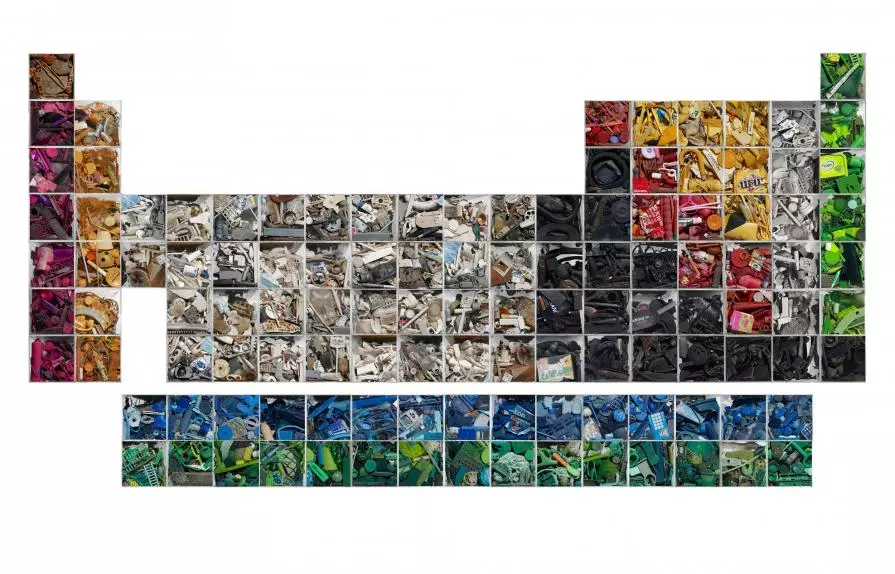
Plastic-Telluric Explorations of Future Dust
Pure and Applied Chemistry
My passion for water has led me to comb the Thames for footprints of the past and future human presence in London. These explorations led me to a new found obsession with the long-term impacts of plastic waste entering carelessly our rivers and marine environments. My latest line of work is built with these discarded plastic objects that I painstakingly collected from various locations in the Thames and various coastal sites. The main purpose of these sculptures is to serve as visual evidence of the long-term properties of these discarded polymers.
In his book "Mythologies" The author (Roland Barthes) devotes a chapter to plastic which he describes as…
"Despite having names of Greek shepherds (Polystyrene, Polyvinyl, polyethylene), Plastic…is the accomplishment of the magical operation par excellence: the transmutation of matter. …At one end, raw, telluric matter, at the other, the finished, human object; and between these two extremes, nothing; nothing but a transit…
So, more than a substance, plastic is the very idea of its infinite transformation; as its everyday name indicates, it is the ubiquity made visible. And it is this, in fact, which makes it a miraculous substance: a miracle is always a sudden transformation of nature. Plastic remains impregnated throughout with this wonder: it is less a thing that the trace of a movement.”
“But the price to be paid for this success is that plastic, sublimated as movement, hardly exists as substance. Its reality is a negative one: neither hard nor deep, it must be content with a 'substantial' attribute which is neutral in spite of its utilitarian advantages: resistance, a state which merely means an absence of yielding. In the hierarchy of the major poetic substances, it figures as a disgraced material, lost between the effusiveness of rubber and the flat hardness of metal; it embodies none of the genuine produce of the mineral world: foam, fibres, strata. It is a 'shaped' substance…But what best reveals it for what it is, is the sound it gives, at once hollow and flat; its noise is its undoing, as are its colours, for it seems capable of retaining only the most chemical looking ones. Of yellow, red and green, it keeps only the aggressive quality, and uses them as mere names, being able to display only concepts of colours.”
“…plastic highlights an evolution in the myth of 'imitation' materials…they aimed at reproducing cheaply the rarest substances, diamonds, silk, feathers, furs, silver, all the luxurious brilliance of the world… And as an immediate consequence, the age-old function of nature is modified: it is no longer the Idea, the pure Substance to be regained or imitated: an artificial Matter, more bountiful than all the natural deposits, is about to replace her, and to determine the very invention of forms. A luxurious object is still of this earth, it still recalls, albeit in a precious mode, its mineral or animal origin, the natural theme of which it is but one actualization. …ultimately, objects will be invented for the sole pleasure of using them …. And the whole world can be plasticized…”
Considering that the above quoted text was first published in 1957 (at a time when few of the negative effects of plastic were publicly evident), these prophetic statements clearly preset both the innate potential and detrimental qualities of this miraculous but potentially toxic substance.
The proliferation of microplastic fragments and dust in the environment is altering the natural geomorphological composition of the earth’s surface.
The message I want to convey through my work is that plastic is not only the cheap, versatile and disposable material (as we have hitherto believed) but also, it is an extremely durable resource with exponentially added values that exceed its original intended use.
Plastic is ultimately proving to be a very expensive commodity; that is, one which we are struggling to keep under control. Estimate calculations for its degradation vary for different types, but can be anything from twenty to thousands of years. Moreover, being photodegradable, once immersed in water and devoid of any source of light or heat in the deep cold darkness of seas, rivers and lakes, it is impossible to predict how long it will lie accumulating onto impermeable layers that disrupt the vital release of oxygen by the oceanic flora.
Another troubling problem that plastic’s presence in water brings has to do with its property to attract and retain toxic substances present in the surrounding water, which are reaching shocking percentages. It is precisely because of this accumulative quality that water-bourne–plastic was given the label of: "Toxic pills".
The main intention of my work is to change the public’s perception to the fact that instead of being a worthless disposable material, these polymers can be reused, recycled and transmuted into something of value to industry and society. Moreover, given its longevity and its polluting characteristics, we should start thinking about perhaps restricting, or even prohibiting its use in disposable products.
Increased reliance on the ocean, as a source of wealth, health and natural resources should sensitize governments, businesses and citizens that drastic measures should be implemented. We need to realise, collectively that these objects have no place in our waters.
The Periodic Table of Chemical Elements is an allegory to the proliferation and the toxic quality of man-made polymer as it merges with our most elementary and purest essence: WATER. The future of dust is plastic.
 Share / Save
Share / Save








Comments 0
Say something